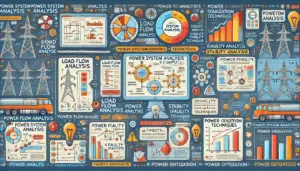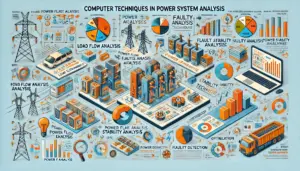CTPSA Notes Pdf – Computer Techniques In Power System Analysis VTU download Free Lecture Notes
Here you can download the Computer Techniques In Power System Analysis PDF Notes VTU as per the VTU Syllabus. Below we have listed all the links as per the modules.
Please find the download links of Computer Techniques In Power System Analysis PDF Notes VTU are listed below:

Computer Techniques In Power System Analysis pdf Lecture Notes – VTU
Description
This guide provides comprehensive notes for the subject Computer Techniques In Power System Analysis tailored to the VTU syllabus. These notes are designed to help B.Tech students understand the essential concepts in power system analysis effectively. The detailed modules cover various aspects from network topology to transient stability studies, offering a solid foundation for your studies.
Computer Techniques In Power System Analysis Notes | PDF, Syllabus, Books | B Tech (2025)
Overview CTPSA Notes Pdf
The Computer Techniques In Power System Analysis notes are meticulously structured to cover all key topics required for VTU’s B.Tech syllabus. These notes are available in PDF format, making it easy for students to access and study anytime, anywhere.
The following topics are covered in Computer Techniques In Power System Analysis handwritten Notes
- Network Topology
- Network Matrices
- Load Flow Studies
- Economic Operation of Power System
- Transient Stability Studies


Links to Download Computer Techniques In Power System Analysis Notes Pdf
Below, you can find the download links for each unit of the Computer Techniques In Power System Analysis notes:
Link: Complete Notes
Link: Part A Notes
Link: Unit 1 Notes
Link: Unit 2 Notes
Link: Unit 3 & 4 Notes
PART – B
Link: Part – B Notes
Link: Unit 5 & 6 Notes
Link: Unit 7 & 8 Notes
Computer Techniques In Power System Analysis Notes and Study Material PDF Free Download
You can freely download the CTPSA notes and study materials from the links provided. These PDFs cover the entire syllabus in detail and are perfect for exam preparation.
Topics Covered in this Computer Techniques In Power System Analysis Notes Pdf
Part A
UNIT – 1: Network Topology
- Introduction: Overview of network topology in power systems.
- Elementary Graph Theory: Concepts of oriented graph, tree, co-tree, basic cut-sets, and basic loops.
- Incidence Matrices: Element-node, bus incidence, tree-branch path, basic cut-set, augmented cut-set, basic loop, and augmented loop matrices.
- Primitive Network: Impedance form and admittance form.
UNIT – 2: Network Matrices
- Introduction: Formation of network matrices.
- Formation of YBUS: Methods including inspection and singular transformation (YBUS = ATyA).
- Bus Impedance Matrix: Step-by-step building algorithm (excluding mutual coupling elements).
UNIT – 3 & 4: Load Flow Studies
- Introduction: Power flow equations and classification of buses.
- Operating Constraints: Understanding the data for load flow.
- Gauss-Seidel Method: Algorithm and flowchart for PQ and PV buses, including numerical problems for one iteration.
- Acceleration of Convergence: Techniques to speed up convergence.
- Newton-Raphson Method: Algorithm and flowchart in polar coordinates with numerical examples.
- Fast Decoupled Load Flow Method: Algorithm for this method.
- Comparison of Load Flow Methods: Evaluating different load flow methods.
Part B
UNIT – 5 & 6: Economic Operation of Power System
- Introduction: Performance curves and economic generation scheduling.
- Economic Generation Scheduling: Neglecting losses and including generator limits.
- Iterative Techniques: Methods for economic dispatch.
- Economic Dispatch Including Transmission Losses: Using approximate penalty factor and iterative techniques.
- Transmission Loss Formula: Derivation and application.
- Optimal Scheduling for Hydrothermal Plants: Problem formulation, solution procedure, and algorithm.
UNIT – 7 & 8: Transient Stability Studies
- Numerical Solution of Swing Equation: Methods including point-by-point, modified Euler’s, Runge-Kutta, and Milne’s predictor-corrector.
- Representation of Power System for Transient Stability: Load representation and network performance equations.
- Solution Techniques: Detailed techniques with flow charts.
CTPSA Notes Pdf from VTU
These notes are tailored specifically to the VTU syllabus, ensuring that you have the right information and insights to excel in your Computer Techniques In Power System Analysis course.
Always Choose Smartzworld to download CTPSA Notes PDF
Smartzworld is your go-to platform for downloading high-quality, reliable, and comprehensive notes for your engineering courses. They provide up-to-date and accurate materials that are essential for your academic success.
Benefits of FREE CTPSA Handwritten Notes PDF
- Comprehensive Coverage: Covers all essential topics as per the VTU syllabus.
- Accessible: Available in PDF format for easy download and access.
- Detailed Explanations: Each topic is explained in detail for better understanding.
- Free of Cost: All notes are available for free, ensuring no financial burden on students.
Conclusion
The Computer Techniques In Power System Analysis Notes for VTU students are an invaluable resource for understanding and mastering the concepts of power system analysis. These notes provide detailed explanations, practical examples, and comprehensive coverage of all topics required by the VTU syllabus. By utilizing these notes, you can effectively prepare for your exams and deepen your understanding of power system analysis.
FAQs
Q1. Where can I download the Computer Techniques In Power System Analysis Notes Pdf?
You can download the notes from the provided links for each unit or the complete set from Smartzworld.
Q2. How to download the Computer Techniques In Power System Analysis Notes Pdf?
Simply click on the download links provided for each unit or the complete notes.
Q3. How many modules are covered in Computer Techniques In Power System Analysis Notes Pdf?
The notes cover a total of eight units, divided into Part A and Part B.
Q4. Topics Covered in Computer Techniques In Power System Analysis Notes Pdf?
Topics range from network topology to transient stability studies.
Q5. Where can I get the complete Computer Techniques In Power System Analysis Handwritten Notes pdf FREE Download?
The complete set of notes can be downloaded for free from Smartzworld using the provided links.
Q6. How to download Computer Techniques In Power System Analysis Handwritten Notes pdf?
Click on the specific unit links or the complete notes link to download the PDFs.
Q7. How to Download FREE Computer Techniques In Power System Analysis Notes PDF?
Visit Smartzworld and use the download links provided to get your free notes.



